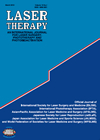Volume 17, Issue 2
Displaying 1-12 of 12 articles from this issue
- |<
- <
- 1
- >
- >|
Editorial
-
2008 Volume 17 Issue 2 Pages 65-67
Published: 2008
Released on J-STAGE: November 02, 2010
Download PDF (684K)
Original Articles
-
2008 Volume 17 Issue 2 Pages 69-74
Published: 2008
Released on J-STAGE: November 02, 2010
Download PDF (2691K) -
2008 Volume 17 Issue 2 Pages 75-81
Published: 2008
Released on J-STAGE: November 02, 2010
Download PDF (645K) -
2008 Volume 17 Issue 2 Pages 83-94
Published: 2008
Released on J-STAGE: November 02, 2010
Download PDF (9971K) -
EFFECTS OF LOW LEVEL LASER THERAPY (LLLT) ON SPASTICITY CAUSED BY CEREBRAL VASCULAR ACCIDENTS (CVAS)2008 Volume 17 Issue 2 Pages 95-99
Published: 2008
Released on J-STAGE: November 02, 2010
Download PDF (772K)
Guidelines
-
2008 Volume 17 Issue 2 Pages 100-102
Published: 2008
Released on J-STAGE: November 02, 2010
Download PDF (79K) -
2008 Volume 17 Issue 2 Pages 103-105
Published: 2008
Released on J-STAGE: November 02, 2010
Download PDF (79K)
LETTER TO EDITOR
-
2008 Volume 17 Issue 2 Pages 106-107
Published: 2008
Released on J-STAGE: November 02, 2010
Download PDF (456K)
REPORT FROM JASLAR
-
2008 Volume 17 Issue 2 Pages 108-110
Published: 2008
Released on J-STAGE: November 02, 2010
Download PDF (408K)
HISTORY OF FOUNDATION
-
2008 Volume 17 Issue 2 Pages 111
Published: 2008
Released on J-STAGE: November 02, 2010
Download PDF (62K)
Calendar of Laser Congresses
-
2008 Volume 17 Issue 2 Pages 112
Published: 2008
Released on J-STAGE: November 02, 2010
Download PDF (49K)
Profile of Authors and Co-Authors
-
2008 Volume 17 Issue 2 Pages 113-115
Published: 2008
Released on J-STAGE: November 02, 2010
Download PDF (580K)
- |<
- <
- 1
- >
- >|
